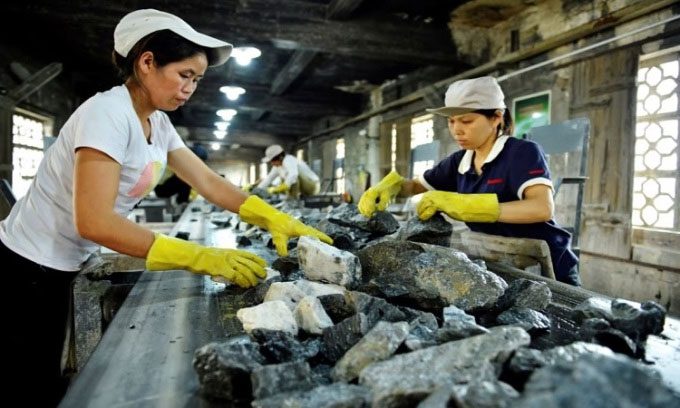A research team at the Chinese Academy of Sciences in Hefei, Anhui Province, has announced the development of the most durable tungsten material that can be used in nuclear fusion reactors.
The new manufacturing technology will allow tungsten to be utilized in applications with the highest demands. Tungsten is one of the heaviest and hardest natural elements, boasting the highest melting point of all metals (3,410 degrees Celsius). This material can enhance the performance of devices used in extreme environments, yet it is very brittle. A component made entirely from tungsten powder is prone to cracking or breaking easily when stretched or subjected to high pressure. In most practical applications, materials scientists must add elements such as nickel, copper, or iron to increase the ductility of the product.

Chinese companies produced 70,000 tons of tungsten in 2019. (Photo: Reuters)
In a paper published in February in the journal Acta Materialia, the research team led by Professor Wu Xuebang at the Institute of Solid State Physics in Hefei shared that they have produced a large block of pure tungsten with a tensile strength of up to 1.35 gigapascals at room temperature, surpassing most current tungsten alloys. The researchers revealed that their project is funded by the government’s nuclear fusion program. The purer the tungsten, the lower the risks for nuclear fusion energy production, according to Professor Fang Qianfeng, a member of the research team.
China’s reactor, also known as the artificial sun, has the potential to produce nearly limitless clean energy through nuclear fusion, similar to the processes occurring in the core of the Sun. The construction of the fusion reactor is expected to be completed in the early 2030s. To generate energy, the reactor will need to heat hydrogen gas to 150 million degrees Celsius, ten times hotter than the core of the Sun.
The hot gas will be contained by an extremely strong magnetic field, but the reactor’s walls will still be exposed to high temperatures, pressure, and radiation. This extreme environment is one that most current materials cannot withstand. Walls constructed from tungsten bricks could address this challenge and sustain the operation of the nuclear fusion plant for many years, even decades. For a long time, scientists have sought to eliminate other impurities in tungsten, as these impurities can cause unexpected disruptions to the fusion reaction.
Wu and his colleagues noted that their technology also has numerous military applications. For example, projectiles made from the new tungsten material may penetrate armor or concrete more effectively due to their greater strength and density. China has the largest tungsten mine in the world. Chinese companies produced approximately 70,000 tons of tungsten in 2019, accounting for over 80% of global production, according to data from the U.S. Geological Survey. The research team in Hefei shared that their new material technology is relatively simple and can be easily scaled up for mass production.
Tungsten cannot be processed using casting methods because most industrial furnaces operate below 1,800 degrees Celsius, which is significantly lower than the melting point of this metal. Instead, workers pour fine tungsten powder into molds and heat it to over 2,200 degrees Celsius until the powder fuses into a crystalline form. However, Wu and his team reduced the temperature to more than one-fifth of that, and then forged the tungsten with extremely powerful hammers. This unique processing method creates a previously unseen layered crystalline structure that can absorb impact energy, making the material durable yet still ductile.




















































